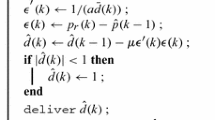Abstract
The continuous growth of wireless services market, fuels the need for precise location dependent services, leading researchers from academia and industry to reassess existing geolocation methods regarding accuracy and availability of position estimation. The proposed method for mobile subscriber geolocation utilizes key concepts from estimation theory and specifically the Kalman filter algorithm to determine an optimal estimate on the actual system state (which primarily includes location, velocity) based on the observations acquired by employing network- or terminal-based techniques, which are briefly presented and assessed thereafter. Given the proven limitations of individual techniques, the alternative strategies for fusion of data are outlined, the details of the operation of a fusion scheme based on the Kalman filter are discussed and the impact of the proposed work over conventional methodologies is quantified.
Similar content being viewed by others
References
Federal Communications Commission, FCC Wireless 911 requirements fact sheet, On-line FCC document library. Retrieved from http://www.fcc.gov/e911/ in January 2001.
Federal Communications Commission, Third Report and Order, On-line FCC document library, Docket No. 99–245, September 15, 1999.
Coordination Group on Access to Location Information for Emergency Services (CGALIES) Report of WP1 CGALIES, “The Coordination Group on Access to Location Information by Emergency Services”. Retrieved from www.telematica.de/cgalies/main.html in 2000.
B. Friedland, Control System Design: An introduction to State-Space Methods, McGraw-Hill, New York, 1987.
A. Gelb, et al. “Applied Optimal Estimation”, MIT Press, 1974.
P.E. Gill, W. Murray, and M.H. Wright, Practical Optimization, Academic Press, 1993.
C. Tomasi, “Mathematical Methods for Robotics and Vision”, Stanford University Pressa.
R.E. Kalman, “A New Approach to Linear Filtering and Prediction Problems”, Transactions of the ASME Journal Basic Engineering,Vol. 82, pp. 34–45, 1960.
M. Silventoinen and T. Rantalainen, “Mobile Station Emergency Locating in GSM”, in Proceedings of IEEE International Conference On Personal Wireless Communications (ICPWC'96), New Delhi, India, 1996.
C. Drane, Positioning Systems in Intelligent Transportation Systems, Artech House, Boston, 1998.
T. Rappaport, J. Reed and B. Woerner, “Position Location Using Wireless Communications on Highways of the Future”, IEEE Communications Magazine,Vol. 34, pp. 33–41, 1996
J. Reed, J. Krizman, B. Woerner and T.S. Rappaport, “An Overview of the Challenges and Progress in Meating E-911 Requirements for Location Services”, IEEE Communications Magazine,Vol. 36, No. 4, 1998.
Federal Communications Commission, “Filing at FCC of TDOA performance by Cambridge Positioning Systems”, On-line FCC document library, 2001.
L.A. Stilp, “Time Difference of Arrival Technology for locating Narrowband Cellular Signals”, in Proceedings of SPIE Conference On Wireless Technologies and Services for Cellular and Personal Communications Services, Philadelphia, Pennsylvania, pp. 134–144, 1995.
J. Liberti and T. Rappaport, (Ed.), Smart Antennas for Wireless Communications: IS-95 and Third Generation CDMA Applications, Prentice Hall Communication, Engineering and Emerging Technologies Series, 2001.
J. Kennedy and M. Sullivan, “Direction Finding and 'Smart Antennas' Using Software Radio Architectures”, IEEE Communications Magazine,Vol. 34, No. 5, 1996.
J.M. Zagami, S.A. Parl, J.J. Bussgang, and K.D. Melillo, “Providing Universal Location Services Using a Wireless E911 Location Network”, IEEE Communications Magazine,Vol. 36, No. 4, 1998.
J. Caffery and G. Stuber, “Overview of Radiolocation in CDMA Cellular Systems”, IEEE Communications Magazine, Vol. 36, No. 4, 1998.
T. Ojanpera and R. Prasad, Wideband CDMA for Third Generation Mobile Communications, Artech House, 1998.
D. Drakoulis and K. Satlas, GPS and Real Time Differential GPS-Setup, Evaluation, Performance and Analysis, Diploma Thesis, Mobile Communications Lab, National Technical University Athens, 1997.
A. Starr, P. Hannah, J. Esteban, and R. Willetts, “Adapting Data Fusion Frameworks for Condition Based Maintenance”, in Proceedings of Fourteenth International Congress on Condition Monitoring and Diagnostic Engineering Management(Comadem 2001), Manchester UK, pp. 209–216, 2001.
E. Waltz and J. Llinas, Multisensor Data Fusion, Artech House, Boston, 1990.
J. Llinas and D. Hall, Multisensor Data Fusion, CRC PRESS, 2001.
T. Kleine-Ostmann and A.E. Bell, “A Data Fusion Architecture for Enhanced Position Estimation in Wireless Networks”, IEEE Communications Letters, Vol. 5, No. 8, August 2001.
S. Merigeault, M. Batariere and J.-N. Patillon, “Data Fusion Based on Neural Network for the Mobile Subscriber Location”, in Proceedings of Vehicular Technology Conference, Boston, pp. 536–541, 2000.
Author information
Authors and Affiliations
Rights and permissions
About this article
Cite this article
Kikiras, P., Drakoulis, D. An Integrated Approach for the Estimation of Mobile Subscriber Geolocation. Wireless Personal Communications 30, 217–231 (2004). https://doi.org/10.1023/B:WIRE.0000049401.97358.c7
Issue Date:
DOI: https://doi.org/10.1023/B:WIRE.0000049401.97358.c7




